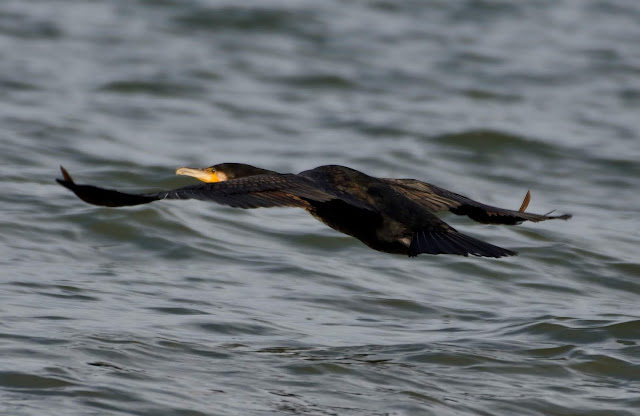Cormorants and Shags........now considered pests!
Whilst I was in the UK photographing these beautiful birds, I experienced huge groups of up to 200 Cormorants, flying from feeding on the coast to their inland roosting sites. It's ironic, that a bird that came so close to extinction during the 20th century, has now reached such large numbers, that it is once again being culled.
My search for these birds, took me from the west coast of Scotland, all the way down to Cornwall in the south west of England and then across to the Thames Estuary in the south east, a journey of 600 miles!
My search for these birds, took me from the west coast of Scotland, all the way down to Cornwall in the south west of England and then across to the Thames Estuary in the south east, a journey of 600 miles!
 |
| Skimming the surface of the sea |
The Cormorant is a large, black, fish-eating bird with a long, hook-tipped bill. They can be seen on both coastal and inland waters. When on water they swim low with their bill raised, and often dive with a leap from the water's surface. Their plumage is not waterproof but this has the advantage of allowing them to dive deep, as buoyancy is reduced. The Shag, which is a close relative, is slightly smaller, with a more angular forehead.
 |
| This is a 'Shag'..... a very close relative to the cormorant. - Note the steeper forehead |
Historically, Cormorant and Shag populations in the UK and close continent have been kept at a low level due to earlier persecution by humans and through reduced breeding success as a result of pesticide pollution in the 1950's and 1960's.
 |
| a juvenile Shag, the darker adult plumage appears at around 3 years |
Following protective legislation in Denmark and Holland in the late 1960s, the European populations increased rapidly and continental birds started to extend their wintering range into UK coasts. Cormorants are now widespread all year round, throughout the UK with the highest densities on the coast, at estuaries and on inland waters. Shags prefer cooler climates and are only to be found in Northern parts of the British Isles.
 |
| This nesting site was at the top of a rock 'stack' just offshore |
 |
| Spot the two chicks in the nest at the front |
In the UK the Cormorant was almost exclusively a coastal breeder until 1981, when an inland 'tree-nesting' colony became established in Essex. Nowadays, Cormorants regularly breed in trees at over 100 separate inland sites in England alone. Shags have not copied this behaviour and still nest on high cliffs, or rock stacks, close to the shoreline.
 |
| Cormorant resting |
Research has found that the timing of breeding between the inland and coastal breeding Cormorants is very different. Coastal birds breed within a very narrow period, with all chicks all hatching at a similar time. In contrast, inland Cormorants have a long breeding season. The large difference in timing of breeding within an inland colony, means that competition for food when chicks are large is reduced.
 |
| Cormorants will often use man-made structures to rest on |
Over the past 30 years, Cormorants have gradually changed their breeding sites from coastal to inland and their numbers have exploded. This is causing huge issues with freshwater and sea anglers and owners of fish farms. There have been calls for the birds to be culled by many angling associations and the UK government is continuing to give permits to achieve a reduction in numbers.
 |
| Classic Pose - Cormorants are often spotted drying their wings between dives |
 |
| Adult and Juvenile - the younger bird has yet to get its darker underbody adult plumage |
 |
| There's always one 'show-off' in every family! |
To read my earlier blogs, please click on 'Previous blogs' at the top-left of this page
If you enjoy my blogs, please 'subscibe' or 'share' them by using the links above



Wonderful set of photos and information. Like the two in flight, but the show off has to be my favourite 😊 A bientot, Diane
ReplyDelete